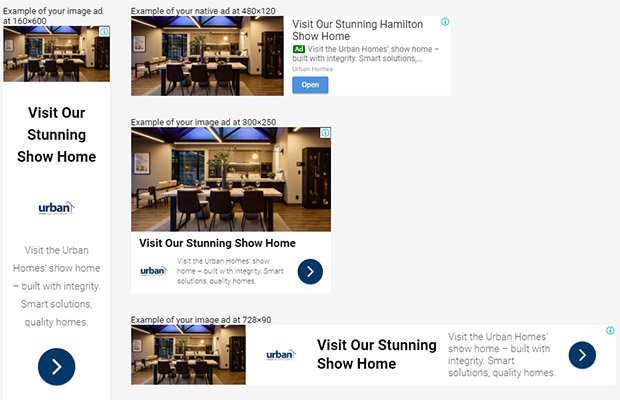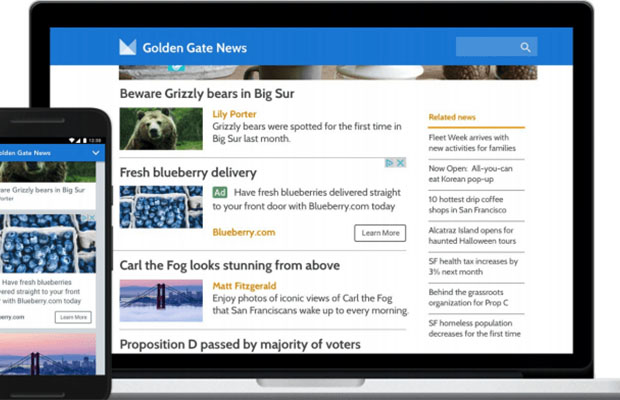This article explains what is responsive display ads, its benefits, how to configure them to help you achieve the maximal ads effect, and more useful points.
But first, do you know what’s a characteristic of Responsive display ads? The answer is shown below:
- They give you more control over how your ads appear and feel.
- By using AMP, they allow publishers to provide a quicker experience.
- They help limit ads to banner-eligible slot
You can upload your assets (such as pictures, headlines, logos, videos, and descriptions) and Google will create ad combinations for websites, apps, YouTube, and Gmail automatically with responsive display ads. Display campaigns may use responsive display advertisements. For more information, keep reading!
Table of Contents
What Is A Responsive Display Ad?
You now know how responsive display ads from Google work by combining machine learning and content from advertisers. Besides, it combines two of Google’s best ad formats: responsive search ads and intelligent display ads.
In addition to supporting Google AdWords Editor, responsive search ads were developed with controls for color and format, feed support, impression tracking, and other features.
Smart display ads feature asset reporting, support for multiple assets, and top combination displays. Because of this combination, responsive display ads are a great display advertising tool for businesses to use.
You May Also Like: What is Ambush Marketing?
What Is The Purpose Of Display Ads?
Display ads are used as an alternative to text ads to interact with potential customers in creative and compelling ways. By choosing users with similar interests in that product or service, you can increase conversion rates by 59 percent by making them more likely to visit your website and take an action like filling out a form or making a purchase.
Digital marketers use the display ad concept to raise brand awareness, re-engage website visitors, and stand out from the competition.

What’s A Characteristic Of Responsive Display Ads Quizlet?
With Google’s responsive display ads, you can create an advertisement once and have it automatically adapt to fit different-sized ad spaces on the internet. This can save you time and guarantee that the greatest number of people see your advertisements. Some key features of responsive display ads include:
One of the main advantages of responsive display ads is that they automatically adjust to fit different-sized ad spaces, as was already mentioned above. This can save you time and effort because you won’t need to make different ads for each size.
Reach a larger audience: You’re also increasing the likelihood that more people will see your advertisement by having it automatically adapt to different sizes.
This is due to the fact that your advertisement will now be qualified to appear in a wider variety of locations, including on websites and applications that might not have previously accepted it.
Another advantage of responsive display ads is that you can use them to make eye-catching visuals such as images and videos for your ads. This is unquestionably something worth taking into account if you’re looking for ways to improve your results because these ads can be particularly effective at promoting conversions.

Why Make Your Responsive Display Ad?
Due to the rise in recent years in both device and internet usage, responsive ads are increasingly necessary. Although companies may believe that concentrating on targeting options like topic targeting, demographic targeting, and others will be sufficient to reach the right audience, these audiences won’t all be using the same device.
Your display campaign’s reception among potential customers is crucial. When you use responsive advertising, you ensure that your target audience sees ads that are well-made, have information arranged according to the device, and make good use of the available ad space to highlight the appropriate interactive elements.
They make sure that the ad size and copy automatically adjust to fit the device and screen size that they are being viewed on. This is why a successful display campaign depends on responsive ads.
Also Read: How Do Responsive Display Ads Use Automation?
How To Configure Responsive Display Ads?
You should be familiar with how to set up responsive display ads if you want to use them. Before launching a campaign, make sure you have a Google Ads account. After creating it, you must sign into your Google Ads account and choose a new campaign.
Once you’ve decided on a new campaign, begin the setup procedure by following these four simple steps.
- Select “Website Traffic”
- Select “Display”
- Choose “Standard Display Campaign”
- Enter Your Company’s Website Address
The dashboard in your Google Ads account is divided into two sections. The required information that we have gathered for you below will be on the left side, with a preview of your advertisement appearing on the right.
Graphics And Logos
There must be at least 1 square and 1 landscape picture. You must make sure that the fit you upload is an accurate as result. Whenever possible, use high-resolution images rather than the bare minimum. Google will let you know which of your uploaded images performs the best.
Extensive Headline
When providing supporting information for your advertisement, long headlines with a 90-character limit work best because they will be displayed rather than a shorter headline. If not, the first description takes precedence. When writing ad copy, advertisers must use this information carefully.
Headlines
Don’t use headlines sparingly; they are an essential part of your advertisements. You are permitted to use up to five headlines. By now, the criteria should be obvious: multiple headlines are the way to go.
Description
Advertisers should communicate their unique selling proposition in the description area. Short, keyword-focused headlines paired with the appropriate content in the description section are essential for achieving successful campaign results because headlines typically have less room.
Related Reading:
- How To Reduce Google Ads Spend And Lower CPA?
- How To Generate Leads In Google Local Services Ads?
- How To Bulk Add UTM Parameters To Google Ads?
How Do Responsive Display Ads Use Automation?
In terms of online advertising, responsive display ads are one of the best means of reaching your target market. These advertisements are perfect for reaching users of mobile devices because they automatically resize to fit any screen size. Furthermore, busy marketers who want to use automation will find them ideal because they’re so simple to create and manage.
Here’s how responsive display ads operate: To start, you create a single ad unit that can be served on all screen sizes. Following that, this ad unit is automatically resized and optimized for each user’s device. Users will always see the best version of your advertisement whether they are viewing it on a desktop computer, tablet, or smartphone.
This helps you save time and effort while also guaranteeing that your advertisement is always interesting and relevant, regardless of where it is seen. Furthermore, responsive display ads are becoming more and more crucial for companies of all sizes as more and more people browse the internet on mobile devices. Google AdWords is a fantastic place to start if you’re interested in testing out responsive display ads for your company.
They provide a wide selection of options and templates that make it simple to create appealing, efficient ads that will be seen by your target audience regardless of the device they are using.

What’s Key Benefit Of Using Responsive Display Ads?
A cutting-edge format choice for advertisers looking to optimize their advertising strategies is responsive display ads. These are the top five advantages of using RDAs for display advertising.
- Optimize your ads: The best asset combination for each ad slot is chosen by Google’s machine learning model based on your performance history when you create a responsive display ad by uploading various assets to Google Ads.
- Broader reach: For example, you can upload multiple headlines, logos, videos, and images for each asset type. To practically fit any available ad space, Google Ads will automatically change the size, appearance, and format of your ads. A responsive display ad, for instance, may appear as a banner ad on one website and as a dynamic text ad on another.
- Use with videos: To extend your reach on the Display Network, you can also include videos in your responsive display ads. When Google Ads believes your videos could improve performance, videos are displayed in place of images.
- Save time: By using responsive display ads, you can spend more time on performance optimization while spending less time managing ad portfolios within ad groups and campaigns.
- Use with feeds: Customers who view responsive ads are shown personalized content from a feed you add and manage, including ads for products they have already viewed on your website or mobile app. Your ads will appear in both dynamic and static formats if you include a feed in your campaign. To create feeds for your responsive display ads, learn more.
Read More: Which Is A Key Benefit Of Bumper Ads?
Facts About Responsive Display Ads
Google’s responsive display ads are a flexible tool for reaching your audience because they automatically resize to fit almost any available ad space.
Several important considerations regarding responsive display ads are listed below: You have more space to work with and a higher chance of being seen with responsive display ads because they can be up to six times bigger than regular text ads.
Google will automatically test various combinations to determine which performs best after you upload multiple images and headlines for your responsive display ad.
Your responsive display campaigns’ effectiveness can be monitored using metrics like clicks, impressions, and click-through rates, just like other types of Google Ads. Consider using responsive display ads if you’re looking for a productive way to advertise to more people.
Standard Display Ads Vs. Responsive Display Ads
Responsive display ads are more adaptable than traditional display ads, which is their main distinction. As was already mentioned, responsive display ads instantly modify their shape, size, and format to fit into open ad spaces on that particular website. In a similar vein, responsive display ads enable you to maximize your advertising, reach a larger audience, save time, work with dynamic remarketing, and much more! Your display ads now give you even more flexibility and control.
In addition, responsive ads can display in three main formats:
- Text – Google’s Display Network upgraded version of text ads
- Image – Comes with a combination of a short headline, relevant images, or a brief description
- Native – Less noticeable images that can match the style and color of the page, and the headline is usually longer
FAQs
What Is Provided By Responsive Display Ads?
The name of these advertisements seriously undersells their incredible capabilities, which are pretty amazing.
But if we had to pick just three, we’d say reach, simplicity, and automation are the three main advantages of responsive display ads.
When Should You Use Responsive Display Ads?
If performance is your main objective, you should use responsive display ads. if you prioritize performance above all else.
Use responsive display ads, which automatically adjust to the available ad space, to the fullest extent possible to accomplish that goal.
Which Statement Is True About Responsive Display Ads?
The ads adjust to available screen space when delivered. This statement about responsive display ads is accurate.
Conclusion
Respondent display ads are being used by more and more businesses to attract potential customers. This kind of advertisement has a user-friendly, interactive layout that adapts to the size of the screen being used to view it.
As a result of users’ search queries, Google uses machine learning and the various assets provided by advertisers to determine the best asset combination to create a display ad.
It has many advantages that help you optimize your ads, expand the reach of your ads and brand, and enable you to upload videos, which Google will automatically highlight if they have the potential to draw customers more than displaying images.
Finally, save you a ton of time so you can concentrate on other performance-related factors while responsive display ads handle your campaigns.
Read Next: How To Advertise CBD?





